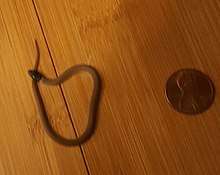Tantilla hobartsmithi
Tantilla hobartsmithi, commonly known as the southwestern blackhead snake, Smith's blackhead snake, or Smith's black-headed snake, is a species of small colubrid snake native to the southwestern United States and northern Mexico.
| Tantilla hobartsmithi | |
|---|---|
 | |
| Scientific classification | |
| Kingdom: | Animalia |
| Phylum: | Chordata |
| Class: | Reptilia |
| Order: | Squamata |
| Suborder: | Serpentes |
| Family: | Colubridae |
| Genus: | Tantilla |
| Species: | T. hobartsmithi |
| Binomial name | |
| Tantilla hobartsmithi Taylor, 1936 | |
| Synonyms[2] | |
Etymology
The specific name or epithet, hobartsmithi, is in honor of American zoologist and herpetologist Hobart M. Smith (1912–2013).[3]
Taxonomy and systematics
T. hobartsmithi was first described by Edward Harrison Taylor in 1936.
Description
The southwestern blackhead snake is a small snake, growing to a maximum total length (including tail) of 15 in (38 cm), but typically averaging around 8 in (20 cm) in total length.
Dorsally, it is uniformly brown in color, except for the black-colored head, which gives it its common name, and a cream-colored or white collar. On the belly, there is a broad reddish stripe, which runs down the center of the ventral scales.[4]
Venom
T. hobartsmithi is rear-fanged, having enlarged rear teeth and a modified saliva, which while harmless to mammals, is believed to be toxic to arthropods, its primary prey.
Behavior
Blackhead snakes (genus Tantilla) are primarily nocturnal and fossorial, spending most of their time hiding in loose soil, leaf litter, or under ground debris.
Diet

Blackhead snakes eat most varieties of soft-bodied insects and centipedes.
Geographic range
The southwestern blackhead snake is found in the southwestern United States, in Arizona, California, Colorado, Nevada, New Mexico, Texas, and Utah, as well as in northern Mexico, in Chihuahua, and Coahuila, and Sonora.[6]
Habitat
The preferred natural habitats of T. hobartsmithi are desert, grassland, shrubland, and forest.[1]
References
- Frost DR, Hammerson GA, Santos-Barrera G (2007). "Tantilla hobartsmithi ". The IUCN Red List of Threatened Species 2007: e.T63947A12730643.https://dx.doi.org/10.2305/IUCN.UK.2007.RLTS.T63947A12730643.en. Downloaded on 11 May 2020.
- "Tantilla hobartsmithi ". The Reptile Database. www.reptile-database.org.
- Beolens, Bo; Watkins, Michael; Grayson, Michael (2011). The Eponym Dictionary of Reptiles. Baltimore: Johns Hopkins University Press. xiii + 296 pp. ISBN 978-1-4214-0135-5. (Tantilla hobartsmithi, p. 247).
- Stebbins RC (2003). A Field Guide to Western Reptiles and Amphibians, Third Edition. The Peterson Field Guide Series ®. Boston and New York: Houghton Mifflin. xiii + 533 pp. ISBN 0-395-98272-3 (paperback). (Tantilla hobartsmithi, p. 400 + Figures 28 & 29 on p. 398 + Map 177 on p. 503).
- Species Tantilla hobartsmithi at The Reptile Database www.reptile-database.org.
- "Tantilla hobartsmithi". Discover Life. Retrieved July 9, 2006.
Further reading
- Blanchard FN (1938). "Snakes of the Genus Tantilla in the United States". Zool. Ser. Field Mus. Nat. Hist. 20 (28): 369–376. (Tantilla utahensis, new species, p. 372).
- Taylor EH (1936). "Notes and Comments on Certain American and Mexican Snakes of the Genus Tantilla, with Descriptions of New Species". Trans. Kansas Acad. Sci. 39: 335–348. (Tantilla hobartsmithi, new species, p. 340).
